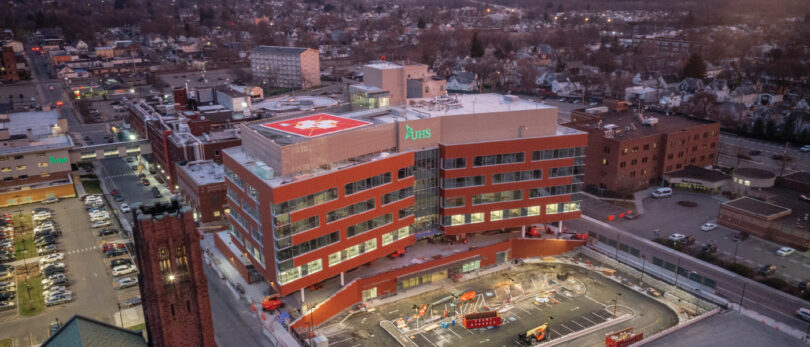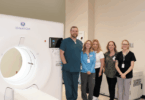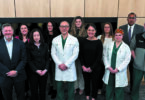UHS Wilson Main Tower set to open with state-of-the-art facilities, unmatched patient privacy and more
The month of May 2024 brings a ribbon-cutting ceremony and a preview of the newly completed UHS Wilson Main Tower, celebrating the long years of hard work, collaboration and passion required for this ambitious project. “It’s just a dream come true for many of us who have worked so many years to see this happen,” says John Carrigg, president and chief executive officer of UHS.
That dream began in 2018 and is set to be fully up and running by 2025, with several preview dates this May. This represents the first significant expansion of UHS Wilson Medical Center in three decades, and is one of a trio of developments, including the new UHS Child Care and the 24/7 UHS Pharmacy Johnson City on Main Street. The tower features six floors and more than 180,000 square feet of state-of-the-art technology and design with patient privacy and optimal care foremost in mind. The tower will offer a new Emergency & Trauma Center, plus inpatient units for neuroscience, surgery, oncology and cardiology patients. A new helipad on the roof will improve care for airlifted emergency patients.
As an important part of financing the expansion, the UHS Foundation has established the Journey Campaign, with a goal of raising $10 million expressly for the Wilson Main Tower. To date, $9 million has been raised in this capital campaign, thanks to the generous support of individuals, corporations and organizations in the community.
Donate Today
To learn more about contributing to the Journey Campaign, call the UHS Foundation at 607-762-2171.
Privacy and comfort
An emphasis on privacy and comfort is an essential component of the new Wilson Main Tower. Creating private rooms with private bathrooms is part of a nationwide trend that results in greater privacy and healing. Whether a hospital is dealing with a pandemic or a more common flu outbreak, the ability to put some distance between patients becomes crucial and easier to accommodate in private rooms.
“Providing a better healing environment for our patients starts with privacy,” Mr. Carrigg adds. “We’ll have 120 private rooms, each with its own bathroom. This healing environment will be transformational for us and for the type of care that we can deliver. We are committed to provide greater privacy for our patients, which is more important today than ever.”
The power of digitization
Each private room will feature a system of digital displays called pCare, an interactive patient engagement system that leverages state-of-the-art television infrastructure to educate, entertain and empower patients. This modern technology keeps caregivers and family members well-connected to the patient and their treatment.
The 43-inch pCare screens display a wide variety of information for patients, their families and the practitioners helping them heal. The screens display and populate real-time data via Epic, the UHS electronic health record management system.
Outside the patient’s door, pCare lists the person’s preferred language and other crucial details for providers and nurses, such as whether the patient is a fall risk or needs a special diet. Inside the room, the system lists details the patient might forget, such as visiting hours or the names of their care team members.
Additionally, these integrated televisions allow patients to watch shows, movies and educational videos about their medical needs and recovery. “If a patient has a new diagnosis, a nurse can line up videos to teach them about their new diagnosis or the procedure that they’re going to have,” says Stephanie Jester, MSN, RN, NE-BC, director of Nursing. “pCare helps our care teams educate and collaborate with patients, integrating with our electronic health record system to optimize the care experience.”
Revolutionizing patient care
Kara Hines, DNP, RN, chief applications officer, oversaw the management of UHS’ electronic health record system and was involved in acquiring the digital system. She shares that, in most hospitals, patient information is handwritten on a conventional whiteboard, which can cause miscommunication due to difficult-to-read handwriting and accidental erasure, or there can be irrelevant or outdated information. The new digital system frees healthcare practitioners from having to write, rewrite or decipher important data and does so instantly.
pCare’s cutting-edge digital boards serve as an innovative solution to potential issues arising from traditional whiteboards inside patient rooms. This advanced technology elevates the patient experience and streamlines communication among healthcare professionals. Additionally, digital door signs are placed outside the patient’s room to communicate information to staff and update automatically.
“Digital boards outside the patient door tell healthcare workers important patient information. Now, instead of me walking into your room, not knowing you’re in isolation, it will automatically update so everyone’s aware in real time. That’s a big win,” Ms. Hines says.
Ms. Jester also feels the new digital display system will enhance the patient’s recovery by encouraging family involvement. “To engage the patient and family with the plan of care, these electronic digital boards are going to have goals for the patient to reach,” she says. If a patient has goals to achieve before an anticipated discharge date—being able to walk a certain number of steps unaided, for example—those goals are displayed. That technology reinforces the education from the nursing staff and, coupled with the educational videos, can show family members how best to support the patient during their hospital stay and after.
Crafting Wilson Main Tower through collective expertise
From the start, the design of the Wilson Main Tower has come with significant contributions of time and expertise from multiple departments, staff and providers, each offering their perspective on what a hospital requires to provide truly excellent care. “We pride ourselves on the fact that, from the beginning, it was a multidisciplinary effort,” says Michelle Karedes, senior director of Strategic Facility Planning.
“Over 125 people, representing all the support services and clinical departments, took part,” she says. “We had main project teams for the Emergency & Trauma Center, the medical/surgical units & Imaging. And then we had support teams such as Purchasing, Transportation, Food and Nutrition, Environmental Services, Biomedical Engineering, Physical Therapy and Pharmacy—all those other individuals were our core support team, who joined in the planning efforts.”
For example, Ms. Karedes met early with Emergency Department representatives and the architectural and engineering teams to discuss what was required for the new, expanded ED to exceed expectations and support clinicians’ efforts. She and her team then shared that information with other teams, who added their input, and the design became fleshed out from that point. “We didn’t design in isolation for one team—we took a multidisciplinary approach. Teamwork and innovation were required to execute this plan,” she adds.
The regional emergency medical services (EMS) community was also invited to engage in a meticulously designed, true-to-scale mock-up of the ambulance entrance and parking area for the ED.
Ms. Karedes says this hands-on experience led to modifications that significantly enhance accessibility and streamline the delivery of care for patients, directly addressing the specialized needs of these critical providers.
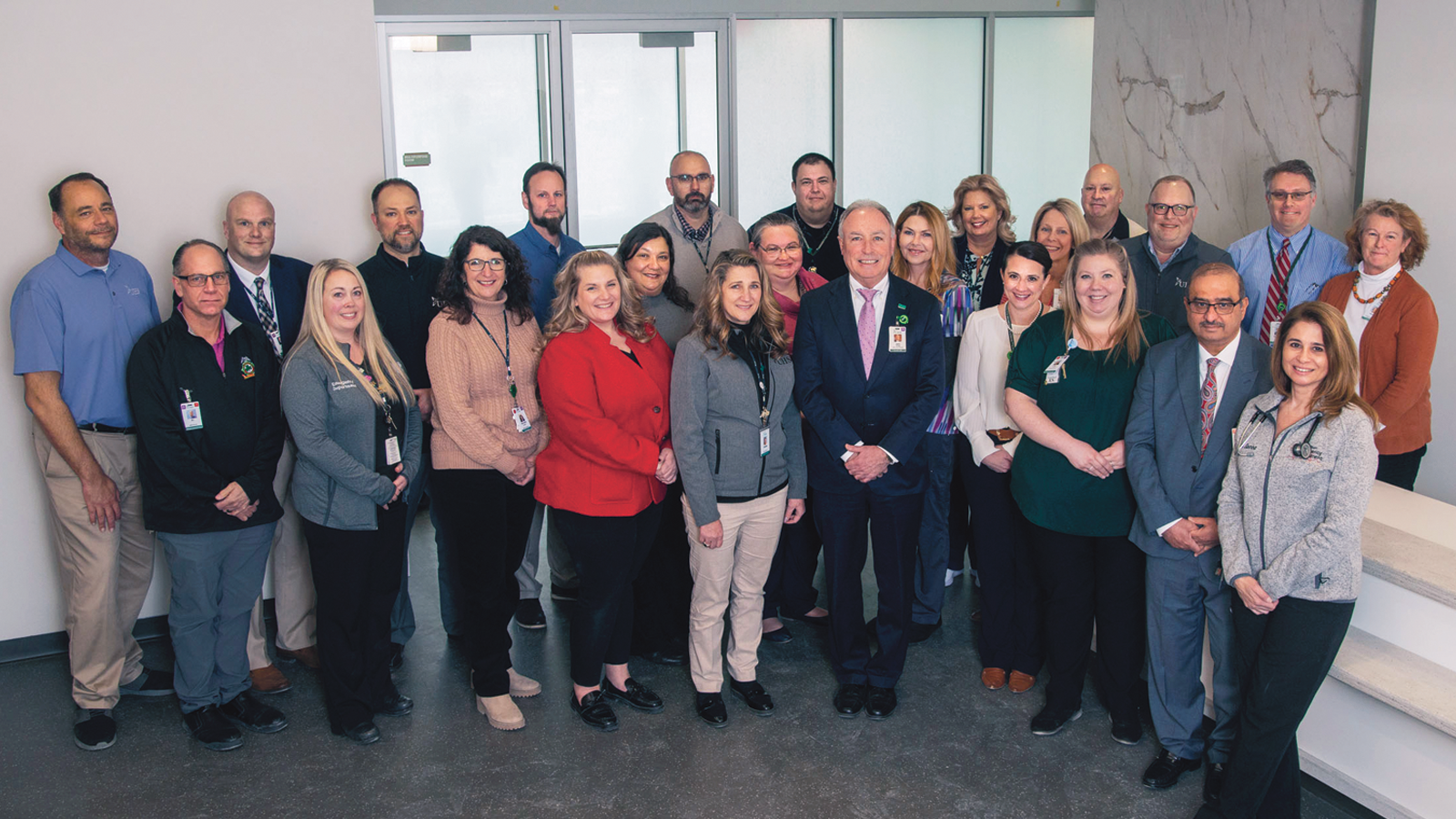
UHS team members from many departments across the organization meet on the third floor of the UHS Wilson Main Tower to prepare for the opening of the six-story building, the new front door to UHS services going forward.
Enhancing care through design
Many of the special considerations in the new tower design focus on the needs of patients and hospital staff, but the visitor experience was also considered. A gift shop is centrally located on the main floor near the entrance. A new meditation room inside the tower provides a space for meditation, prayer or quiet reflection, offering visitors a place of peace where they can process what they or their family member is going through, away from the fast pace and intensity of the hospital environment. If a visitor sees a beloved relative or friend, even in the best circumstances, this can be an emotionally trying encounter. The meditation room has plentiful windows high off the ground to provide light while maintaining privacy, so visitors can gaze out comfortably and calmly if the weather makes it uncomfortable to do so outside.
Innovative dining meets sustainability
To address nutritional needs, Ms. Karedes met with the design team and Food & Nutrition staff members. While other dining areas are on the larger campus, we wanted to avoid repeating what was offered elsewhere. “We wanted to offer new options,” she says. In addition to grab-and-go items, the Main Street Café in the tower will serve salads, grain bowls and other customizable meal options made fresh and to order. The café seats 70 indoors, but an outdoor terrace is adjacent to it, complete with tables, umbrellas and benches. Since the campus is large but has few green spaces, this area will provide staff and visitors with a calm area where they can enjoy some fresh air, weather permitting.
Environmental impact is top of mind, Ms. Karedes notes, and the food services are no exception. UHS will also partner with a local farmer to take food waste away and convert it into compost.

Take a Tour
To view an interactive map of Wilson Main Tower, visit nyuhs.org.
A triumph of teamwork
The Wilson Main Tower project began before the pandemic, but COVID-19 affected all avenues of life, and construction is no exception. Although the pandemic presented many challenges, the team surmounted them. “The pandemic dominated our work, our world and healthcare for four years,” Mr. Carrigg says, citing issues with supply and labor shortages and skyrocketing prices for construction materials. But construction continued despite these obstacles, something Mr. Carrigg attributes to teamwork and dedication.
“This is a great testament to all the people who have worked on this generational project,” he says. “All of those challenges that we’ve all faced in our everyday lives through the pandemic, we felt here. We persevered through it all and realized our strategic vision from several years ago. I’m very grateful to the team members who made the Wilson Main Tower happen.”
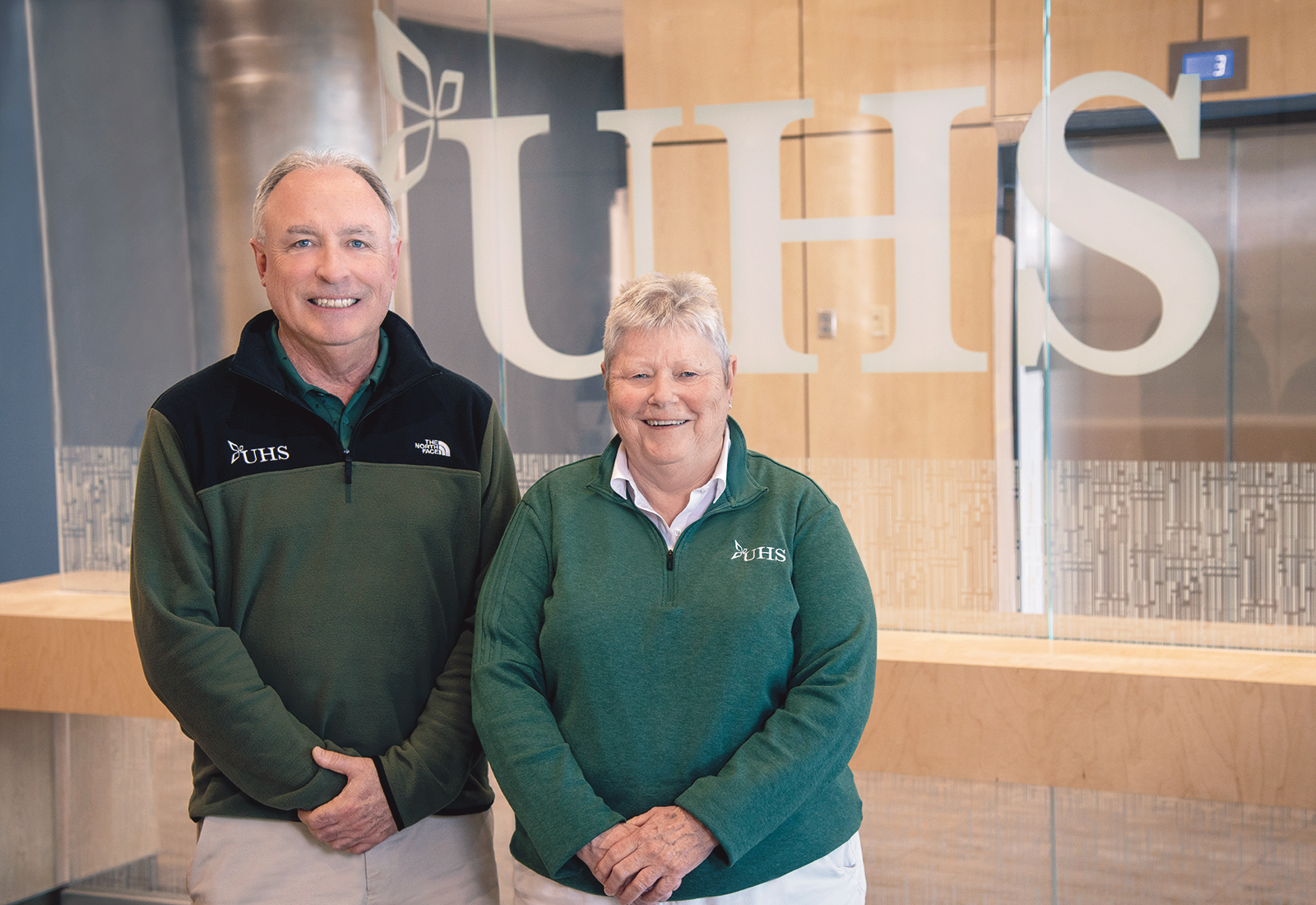
Executive leadership to make the UHS Wilson Main Tower a reality has been provided by a team led by John Carrigg, president and chief executive officer of UHS, and Kay Boland, RN, senior vice president, chief nursing officer and chief operating officer of UHS.
Employment Opportunities
As UHS grows and expands to meet the changing needs of the Southern Tier, many career opportunities are available for qualified healthcare professionals. To view current job openings, visit the UHS careers page under “Join our Team” at nyuhs.org.

